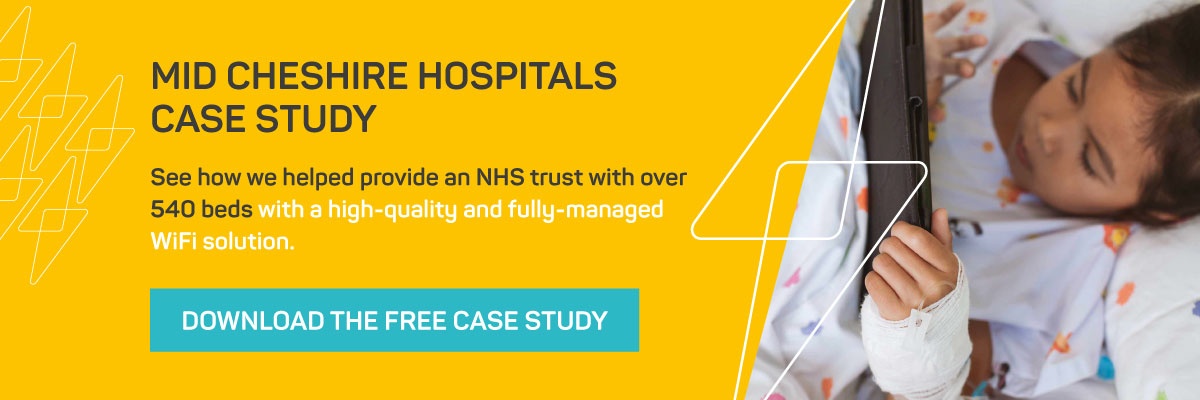5 Ways Hospital WiFi Can Improve NHS Productivity and Efficiency
6 minute read | 23/05/2018

Access to public WiFi is no longer a nicety - it’s almost a necessity. Most of us rely on digital connectivity to go about our daily lives, using social media and surfing the web on our phones, but signal can fluctuate inside buildings, particularly in large hospital buildings. This is why WiFi should be a part of a Trust’s technical foundation. But there are other reasons too. Here are some ways hospital WiFi can improve NHS productivity and efficiency.
From optimising the delivery of healthcare services to improving the overall hospital experience for a patient, WiFi can bring a number of benefits. These include:
- Reduces Likelihood of Delayed or Missed Appointments
- Smart Analytics to Help Form More Educated Decisions
- Hospital Staff Can Focus on Other Tasks
- Improving Patient Mood to Boost Overall Hospital Environment for Both Staff and Other Patients
- Boosting Awareness with Targeted Patient Messages
1. Reduces Likelihood of Delayed or Missed Appointments
When patients first arrive for their appointments, they enter an airport-like lobby, bustling with people and often have no idea where they’re supposed to go.
With seemingly identical corridors and confusing signs, it’s easy to become lost and then be late for or miss an appointment. This then leads to appointments running over and the associated knock-on effect. This can irritate other patients and cause staff unnecessary stress when they struggle to meet targets. As a result, waiting lists can become even more backed up.
Hospital WiFi can help by providing patients with all of the information they might need. On their own device, they can access the Patient Engagement Portal without needing to sign up to the WiFi. This portal contains plenty of useful information - including a clear digital map and easy directions to the appointment room.
This means patients can successfully navigate themselves around the hospital and get to their appointments on time, which prevents subsequent appointments from being delayed.
2. Smart Analytics to Help Form More Educated Decisions
WiFi offers more than just connectivity. NHS Trusts can also collate intelligent WiFi analytics, which offer valuable insight into anonymous patient trends, such as how long they stay, how they move across the site and when the busiest times are on different traffic routes.
This can promote smart spending. Knowing when the busiest times are means management can allocate resources, such as staff and equipment, more effectively. This means you can create a patient and visitor environment which is sharper and more pleasant.
Knowing how long visitors stay in a hospital can help Trusts figure out how to deliver their onsite facilities more effectively to them. For example, if a hospital knows visitors typically spend longer than 15 minutes waiting, they may benefit from a cafe or a gift shop to browse through - to help them pass the time.
3. Hospital Staff Can Focus on Other Vital Tasks
When people arrive at a hospital, they tend to seek staff assistance - usually because they don’t know where to go. Staff are spending time helping patients with non-medical queries - time that could be spent on other more vital tasks.
A customised Patient Engagement Platform (PEP) can solve this issue. PEPs can be accessed in the same way as joining the WiFi service. These platforms are unique to the individual Trust and can only be accessed while the patient or visitor is onsite, which allows them to make best use of the facilities available to them.
When patients and visitors select to sign into the WiFi, they will be redirected to a Portal which allows them to search for and perform actions that they currently need staff assistance with. This might include checking into an appointment, finding out where to go or even ordering meals if they need to stay overnight at a hospital. This means staff can spend more time focusing on their vital healthcare-related tasks.
In addition, because the PEP allows patients to check in and find their way around the hospital themselves, the hospital doesn’t need to invest in more expensive check-in and wayfinding terminals. Those funds saved can then be invested into other aspects of the Trust instead.
4. Improving Patient Mood to Boost Overall Hospital Environment for Both Staff and Other Patients
As well as allowing patients and visitors to access all of the information they might need about the hospital, such as checking into appointments and finding out where to go, PEPs also help to keep people entertained.
When patients are sitting around in a waiting room, they can become bored, anxious and agitated. Phone signal often fluctuates but WiFi means uninterrupted connectivity for people to surf the web, check social media and more to help pass the time while they wait.
Engagement platforms provide even more than that. A customised patient entertainment service enables free delivery of live TV and movies directly to the patients’ devices - as long as that device is web enabled. There are usually similar services in some wards but not all, meaning inequality of service which leaves many patients bored, anxious and in bad moods.
Associated benefits also include ward staff having to spend less time arranging repairs to in-situ TVs or entertainment devices, or relocating in-patients to another room or ward where entertainment services are working.
These entertainment services don’t just keep patients entertained - they also include information about the hospital, including services, surveys and meal ordering. It even includes insight into the patient’s own care. This allows the patient to be kept in the loop with the status of their healthcare, preventing any miscommunication between the NHS and the patient.
This helps to improves the patient’s mood, boosting their overall hospital experience and making it more likely that they’ll cooperate with the health staff. This then has a positive impact on the staff’s working productivity and efficiency.
5. Boost Awareness with Targeted Patient Messages
Prevention is better than finding a cure, but it’s easy for patients to ignore letters and leaflets through the post, or to look straight past posters on the walls of the hospital or GP’s surgery.
However, patient and visitor WiFi connectivity means health promotion messages can be sent directly to visitors’ phones whilst they’re on site. From targeted messages about vaccinations and “book a check up reminders” to other tailored messages, banners on the PEP can prompt people to book that prevention appointment while they’re at the hospital and before they forget.
Hospital WiFi Offers More Than Just Connectivity
A robust and reliable WiFi connection is more than just convenient. Ultimately, it’s the all powerful qualities of a WiFi connection (and the infinite wealth of information that follows) that helps to boost working productivity and efficiency. This is precisely why it’s one of the most important parts of the NHS framework.
And top of all this, WiFi and having ultra connectivity helps improve a patient’s entire hospital experience - from the moment they step into the building to when they walk out. Hospitals can be intimidating places and many people can feel isolated. WiFi allows them to stay in touch with their loved ones, while showing them every facility available on site at one convenient tap of a touch screen to keep them entertained.
It’s important that your Trust can harness these benefits too.
Want to Find Out More Information on the Benefits of Hospital WiFi?
These are just a few of the benefits healthcare WiFi can bring to your Trust’s hospitals. It’s not just improved productivity and efficiency that you can experience. To find out more about ultra connectivity, customised patient engagement portals and what they can bring to the healthcare sector, download a copy of SPARK TSL’s Healthcare Case Study.
About the author
Rebecca O'Donovan
Becky is the Marketing Director at SPARK TSL, of whom she has worked for since 2012. She is responsible for high-level marketing strategy focusing on lead generation and aiding the vision of the business to ensure business growth.
More articles by the author
Related articles
 Healthcare Industry
Healthcare Industry
The Holistic approach to Healthcare WiFi
The Future of Patient Engagement by Tracy Scriven, Director of Healthcare UK.
.jpeg?quality=low&width=386&height=180&name=pexels-fauxels-3184465%20(1).jpeg) Company News
Company News
How to Become a WiFi SPARK Partner
As a WiFi SPARK partner, you’ll make a difference to your customers through innovation. You’ll be in a ...
 Healthcare Industry
Healthcare Industry
How WiFi Can Help Reduce Patient Complaints in Healthcare
By 2019, it will be compulsory for all NHS Trusts to offer free WiFi to patients. Digitalisation is one of ...


